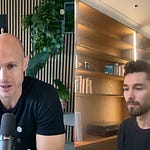Welcome back to the EUVC Podcast — where we go deep with the people shaping European venture.
Today, David sits down with Kristaps Ronis, Partner at ION Pacific, a global secondaries investor (HQ in LA, presence in Europe & Asia) focused on Series B+ tech and a specialty that’s getting hotter by the month: structured secondaries.
Kristaps runs ION Pacific’s European practice and has been with the firm since inception (2015). In this episode, he unpacks why DPI is king, why traditional “sell-the-shares” secondaries often fall short, and how structured deals can deliver liquidity without selling or signaling — all while preserving control and upside for GPs.
Whether you’re a GP under LP pressure, an LP looking for distributions, or a founder trying to understand what’s happening around your cap table, this one’s for you.
Here’s what’s covered:
00:55 – Who is ION Pacific? Global secondaries focused on B/C/D with a European practice led by Kristaps.
02:36 – What they do: Liquidity for venture via structured & traditional secondaries.
04:01 – Kristaps’ path: Latvia → Peking University → Hong Kong banking → co-founding ION Pacific.
06:05 – What are structured secondaries (in one line).
07:35 – Three big learnings in venture: lack of financial innovation, complex cap tables = silent killer, DPI is king.
10:48 – Early vs. later stage instruments — why complexity hits hard post-Series B.
17:16 – Why secondaries now (esp. in Europe): DPI pressure, awareness, more dedicated players.
21:09 – Continuation vehicles in Europe: “2025 is the year of the EU CV.”
23:31 – Where structured deals fit: liquidity without selling, pricing gaps, zero market signaling.
26:20 – “What’s the catch?” Educating LPs on partial upfront + future upside.
28:05 – Advice for GPs & LPs: how to open the liquidity conversation.
29:53 – Solving the bid–ask spread: structure beats headline discounts.
31:27 – Co-investing: where others join (and where they don’t).
32:26 – The market gap: too big for small PE secondaries, too small for mega funds — ION’s sweet spot.
35:55 – Timing: don’t start in year 11 of a 10+2 fund; think 6–9 months ahead.
36:58 – Seller mistakes: timing, portfolio prep, governance blockers, LP comms.
40:23 – Good news for emerging managers: relationships can reopen info rights.
43:37 – Kristaps’ bookshelf: The One Thing, Getting to Neutral, Buy Back Your Time.
45:23 – How to reach Kristaps: LinkedIn + email; open to being a sounding board.
📝 Show Notes
What are Structured Secondaries?
A way to deliver liquidity without selling the asset.
Investor provides partial upfront cash today and shares future distributions.
Benefits: no market signal, no loss of control, preserves upside; ideal when bid–ask spreads are wide (e.g., 2020–21 rounds vs. today’s fair value).
Why they’re rising (esp. in Europe)
DPI pressure: “DPI is king.” IPOs have been slow; funds need distributions.
Awareness & adoption: PE did this for decades; venture is catching up post-2015.
Shift in deal types: From single-asset/Founder liquidity → fund-level transactions and continuation vehicles (CVs).
When to prefer structured vs. a straight sale
You believe selling now would be premature.
You think the market is mispricing your best assets.
You don’t want to be seen as a seller (corporate VC & reputationally sensitive GPs take note).
Continuation vehicles in Europe
Expect more: 2025 dubbed “the year of EU CVs.”
CVs move portfolios or trophy assets to a new vehicle for more time/upside while delivering DPI.
Common mistakes sellers make
Timing: Start 6–9 months before you need liquidity; don’t wait for year 11 of a 10+2 fund.
Portfolio prep: Curate assets; ensure info packs (plan, financials, cap table, SHA), especially if you’re a small/early check.
Ability to close: Clean up ROFRs/pre-emptions, debt tangles, weird prefs.
LP comms: Educate LPs early—structure, timeline, choices (sell/roll), expected impacts.
Emerging managers — yes, you can
Even without strong info rights, relationship capital with founders often reopens access (under confidentiality) to get a deal done.
Deal sizes & co-invest
ION Pacific often partners on unstructured (e.g., CVs); structured deals are more often bilateral.
Market gap: Too small for mega secondaries (>€100–150m), too bespoke for micro. Structured deals typically make sense from ~€5m+ given legal/structuring overhead.
Reading list (Kristaps’ rotation)
The One Thing: Gary Keller & Jay Papasan
Getting to Neutral: Trevor Moawad
Buy Back Your Time: Dan Martell
🎯 One-liner Takeaway
Liquidity without selling is no longer a paradox: structured secondaries let GPs deliver DPI, preserve upside, and avoid negative signaling when the bid–ask spread is wide.
🤗 Join the EUVC Community
Looking for niche, high-quality experiences that prioritize depth over breadth? Consider joining our community focused on delivering content tailored to the experienced VC. Here’s what you can look forward to as a member:
Exclusive Access & Discounts: Priority access to masterclasses with leading GPs & LPs, available on a first-come, first-served basis.
On-Demand Content: A platform with sessions you can access anytime, anywhere, complete with presentations, templates, and other resources.
Interactive AMAs: Engage directly with top GPs and LPs in exclusive small group sessions — entirely free for community members.










